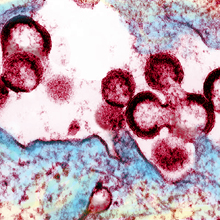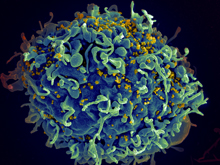Research & Training
Advances in HIV/AIDS Research

HIV virions budding and releasing from an infected cell. Credit: NIAID, NIH
View
Larger Image
For an update on what medical science is doing to fight the global HIV/AIDS pandemic, read a Parade article by NIH Director Francis S. Collins and NIAID Director Anthony S. Fauci, AIDS in 2010: How We're Living with HIV (PDF - 1.5 MB).
Over the past several decades, researchers have learned a lot about the human immunodeficiency virus (HIV) and the disease it causes, acquired immunodeficiency syndrome (AIDS). But still more research is needed to help the millions of people whose health continues to be threatened by the global HIV/AIDS pandemic.
At the National Institutes of Health, the HIV/AIDS research effort is led by the National Institute of Allergy and Infectious Diseases (NIAID). A vast network of NIAID-supported scientists, located on the NIH campus in Bethesda, Md., and at research centers around the globe, are exploring new ways to prevent and treat HIV infection, as well as to better understand the virus with the goal of finding a cure. For example, in recent months, NIAID and its partners made progress toward finding a vaccine to prevent HIV infection. Check out other promising areas of NIAID-funded research on HIV/AIDS at http://www.niaid.nih.gov/topics/hivaids/Pages/Default.aspx.
Other NIH institutes, including the Eunice Kennedy Shriver National Institute of Child Health and Human Development and National Institute on Alcohol Abuse and Alcoholism, also support research to better control and ultimately end the HIV/AIDS pandemic. Some of these researchers have found a simple, cost-effective way to cut HIV transmission from infected mothers to their breastfed infants. Others have developed an index to help measure the role of alcohol consumption in illness and death of people with HIV/AIDS .

Scanning electron micrograph
of HIV particles infecting a human T cell. Credit: NIAID,
NIH
View
Larger Image
Find out more about these discoveries and what they mean for improving the health of people in the United States and all around the globe.
Other NIH institutes, including the Eunice Kennedy Shriver National Institute of Child Health and Human Development and National Institute on Alcohol Abuse and Alcoholism, also support research to better control and ultimately end the HIV/AIDS pandemic. Some of these researchers have found a simple, cost-effective way to cut HIV transmission from infected mothers to their breastfed infants. Others have developed an index to help measure the role of alcohol consumption in illness and death of people with HIV/AIDS .
Find out more about these discoveries and what they mean for improving the health of people in the United States and all around the globe.
Learn more about research in these areas:
 Search for HIV Vaccine Gets a Shot in the Arm
Search for HIV Vaccine Gets a Shot in the Arm
 Preventing Mother-to-Child Transmission of HIV
Preventing Mother-to-Child Transmission of HIV
 Preserving Health and Prolonging Life for People with HIV
Preserving Health and Prolonging Life for People with HIV HIV/AIDS Info Center
HIV/AIDS Info Center
Social Media Links